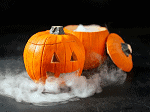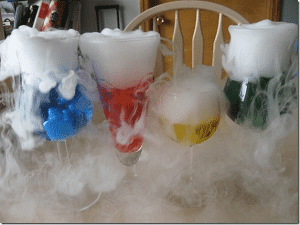Dry Ice is used in many different ways because of its frigid temperature. From Halloween fun to shipping frozen goods, discover all its uses.
Applications for Dry Ice
Home Uses


Family Fun
Use 50 to 100 pounds of Dry Ice dropped directly into a heated swimming pool will make fog for up to an hour or longer, depending on the water temperature and the size of the Dry Ice pieces.
Because of the Jacuzzi’s hot water, it makes the most fog the quickest. As long as the water is kept hot, it can take 50 to 100 pounds per hour. The dry ice will carbonate the water for several days. If possible, drain the Jacuzzi. The swimming pool will read more alkaline during this time so wait to add acid until the carbonation has dissipated. If the water temperature in a swimming pool, fountain, waterfall, or birdbath is too cold (less than 60°F), the dry ice will bubble but produce much less fog.
Ensure there is enough ventilation because CO2 is heavier than air and will accumulate in low places and could cause suffocation. Do not use dry ice in an indoor pool.
Dry ice is the best way to get that creepy, spooky graveyard effect for Halloween. See our spooky fun with Halloween Dry Ice! We include how to make fog, witches brew, spooky pumpkins, and smoking cocktails.
The frigid, dry ice will condense metal and shrink small dents.
Place the dry ice on the inside of the dent, if possible, using heavy gloves. If unable to get to the inside concave part of the dent, hold the dry ice so a corner can fit into the bottom lowest part of the cratered dent. Keep pressing the dry ice until the metal is frosted at least 2 inches beyond the dent. Let the metal warm-up (in the sun is the best) and repeat the procedure. Sometimes the dent will pop out perfectly. Otherwise, it will reduce the dent noticeably. Creased metal will still show the crease line, but the dent will be less pronounced. I have not seen any paint damage, but it could peel if it is broken.

Floor Tile Removal Guidance Photographs
Dry ice will loosen floor tiles by freezing and slightly shrinking them, breaking the adhesive bond and allowing easier removal. Place the dry ice pieces centered on the tile and wait until it is frosted. If it has not popped off, slight tapping with a hammer or prying with a screwdriver will allow it to be lifted off easily. It is ideal for removing a few tiles that need replacing.
To make a fantastic dry ice volcanic eruption, run hot water and put a small amount of dry ice in your garbage disposal. Use safety goggles and stand back. This will make a marvelous eruption. CAUTION: If you put too much dry ice into the sink, it may burst the pipes. When the heavy dry ice sinks to the bottom of the pipes or goes past the “U” shape trap, it sublimates back into its’s gas form. The pressure could break the pipes. Feed small amounts of dry ice at a time, being sure to run enough hot water to consume it.

Placing dry ice at the bottom of a dry food storage container is an economical way to fumigate and store dry goods for an extended amount of time. Make sure the dry ice is not frost-covered, as that will add moisture. Put one quarter to half a pound of Dry Ice per five-gallon storage container in the bottom and then pour in the dry food. As the dry ice sublimates, it replaces the oxygen in the container with CO2. Leave the lid on but not tightly sealed until the dry ice completely sublimates. (About 3-4 hours); then snap the lid tight. If the lid buldges, vent the lid to let out the extra gas. If it sucks in, that is good, as the grains may absorb some of the air. Without oxygen, neither bugs nor bacteria can grow. This process is good for seeds, grains, legumes, flour, powdered milk, rice, etc.
This is a great way to store food for future needs. See ProvidentPrepper for more.

Karyn Gilbert writes: “I use dry ice to freeze my strawberries – fresh, washed ones, once a year:
Wash fresh strawberries
Place directly on top of dry ice in cooler for about 20-30 minutes
Close cooler
Remove when solid
Place in a freezer-safe plastic bag, mark with date
Place in the freezer – to thaw take out and set on a plate at room temp (use within a year to be sure freshness)
They will thaw almost like fresh – without being soggy like usual, frozen strawberries are.
I suppose this might work for other fruits and veggies because of the quick freeze time, not allowing them to get soggy.”

Dry ice is heavier than air and will find its way to the bottom of gopher dwellings. Place 1 to 2-inch pieces as deep into each hole as can be reached and fill the front of the hole with dirt. If you miss some holes, the process may have to be repeated. Jerry Yamamoto of Hayward, California, reports that he successfully used dry ice to eradicate regular Argentine ants from his front yard. Perhaps this could work on fire ants too.

CO2 may attract mosquitoes away from animals and people. Place pieces of dry ice up-wind away from areas where people are congregating. The theory is that mosquitoes find animals and people by their CO2 exhaled during breathing. Melissa Palm reports that dry ice does attract mosquitoes. “I use dry ice in some of my mosquito traps as bait and find that it works rather well.” The Clarke Family of Companies of Roselle, IL., sells a mosquito trap designed for dry ice. Tests show mosquitoes do not spread Covid 19
Dry ice will keep flowers cool and delay blooming by maintaining readily to flower plants at 34°F. Do not allow dry ice to get too close and freeze plants. Dry ice will also promote plant growth and is now used in the marijuana industry.
I STORED DRY ICE FOR ONE YEAR!
One customer told us how sure she was that the paper bag full of leftover dry ice from last year’s Halloween would be available this year because she had never opened the bag for the whole year. Unfortunately, there was no dry ice left – empty inside – but there was plenty of hardened frost around the outside of the bag, frozen solid in the shape of a brick.
BAR MITZVAH
I placed two fog machines at each corner of a wooden dance floor. When they were turned on, the fog filled the floor. The kids came in and sashayed around for ten minutes. They were completely delighted. Later, the fog machines were turned on again for several special dances, filling the floor with fog.
SHIP ON STAGE
Laguna Playhouse, in California, built a large 15-foot-long ship for the final scene of the play and rolled it out on stage with four actors on it. A mechanical device rocked this ship back and forth. When the curtains opened and the stage filled with fog, it really looked like the ship was in the water, gently rocking back and forth.
When finished with the dry ice, unwrap and leave it at room temperature in a well-ventilated area. It will sublimate from a solid to a gas. DO NOT leave dry ice unattended around children.
Industrial Uses
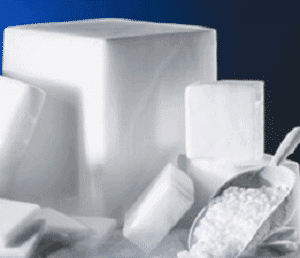

Looking for a fast, easy way to clean impossible-to-reach tight spaces like ductwork and pipes in your plant or facility without shutting down? Turn to Emory Industrial Services for Duct and Pipe Cleaning.

Dry ice is used to super cool alcohol for branding horses, cattle, and hunting dogs.
The alcohol must be 90% pure – not rubbing alcohol. Liquid nitrogen is too cold to work properly. “This is now the second most common way to brand,” said Tony Clark of Bassett, Nebraska.
“The animals show little pain response compared to hot-iron branding. There are no big open wounds . . . so the issue of flies bothering the wound is minimized.
Commercial producers should seriously consider freeze branding. Producers thinking of switching to freeze branding should ask a participating purebred breeder to find out where they get it done, the time involved, and the results.”
From Dvm, Roy Lewis.
Branding videos: https://youtu.be/gsDMipU5wmA
https://youtu.be/o1pX4gC0f_s
WhenCO2 is added to plain water; it will make sparkling mineral water. CO2 is extensively used throughout the world in the beverage industry for making soda pop.
CHEMICAL RETARDANT
Its low temperature slows or stops some chemical reactions. It is used to store and ship special adhesives. It is also a neutralizing agent for alkalis.
PRESSURIZING AGENT
When dry ice changes from a solid to a gas, it absorbs heat and expands to over 800 times its original volume.
DEFLASHING MOLDED PLASTICS AND RUBBER
Dry ice will cool and shrink whatever it touches. Rubber parts are tumbled in a barrel with dry ice, making them brittle for easy flash removal. It is used in cold grinding of Plexiglas, PVC resins, and vinyl.
FRESH MEAT PROCESSING
Dry Ice will keep the temperature cold and reduce spoilage while processing meat. This is used in the industrial processing of ground meats and sausages.
Terminix and other pest removal agents have found that dry ice works as well or better than high heat in sussessfully getting rid of bed bugs.

Small Pests can Cause Big Problems
Jim Lockhart of Littleton Colorado writes: “After allowing the infected cabinet to spend 18 hours in the closed freezer with 30 lbs of dry ice at -25 deg F, I went ahead and removed the dry ice, saving what was left of it in a small ice chest. I closed the freezer up again and allowed the cabinet inside to slowly warm up to room temperature (another 12 hours), then took it out. I checked for signs of life with a stethoscope in the places where the powder post beetles could be heard and – not a sound. I checked again for signs of life 24 hours later – still nothing. It would appear that the insects either froze, suffocated or both. Of course, I have no way to tell whether or not the freezing or lack of oxygen also killed any eggs – only time will tell. I am confident enough that this worked and would recommend it to anyone in a similar situation. Feel free to include any and/or all the info I’ve given you on your website. This is a much less toxic way of killing insects than the use of chemical sprays and fumigants.”
Jim writes one year later to update there is no sign of any beetle activity, and “I’ve been telling fellow woodworkers about the idea, and they, too, have met with success without doing any damage to the wood or its finish.”
MEDICAL USE
Doctors, to freeze skin for wart removal, use Dry Ice or liquid nitrogen. Many medical offices ship biological specimens in dry ice for laboratory testing or further processing. Dry ice is also used to keep bone marrow frozen when it is shipped.
INERTING MEDIUM
Dry ice will replace oxygen in a container preventing or putting out fires. It is used to remove underground gas storage tanks safely.
OIL INDUSTRY
Dex Welch reports, “Dry ice has been used in the oil fields for years to clean tank bottoms. When paraffin, sludge, etc., build up, a chemical is added along with dry ice to roll (stir up) the tank bottom. This breaks out the liquids & separates water from oil in paraffin mixtures so that water can be removed & the oil saved.” Liquid CO2 is also used to crack and increase oil flow in wells. It is also widely used to clean the drilling equipment as the cold temperature will blast clean oil and sludge faster than any other method.
Dry ice can provide CO2 for quicker plant growth and is used in the legal growing of marijuana and other plants in greenhouses. Plant growth increases significantly with extra CO2 and light.
SHRINK FITTINGS
Dry ice will shrink metal to slide on sleeves, bushings, or bearings. Add dry ice to a 90% pure alcohol bath to create a cold liquid near -109.3°F. that can be used like liquid nitrogen.
WELLS
Dry ice combined with detergent, or alone, will improve porosity in irrigation wells. Bill Hayoz of Reliant Dry Ice in New Mexico explains that dry ice is used regularly by ranchers to improve water flow. He used about 60 pounds of dry ice in his windmill well, capped it off, and waited several days before the water came back with a greater flow. The city of Mosquero used 800 pounds of dry ice for their city wells. Most well men will use dry ice before drilling deeper.
Cleaning with cold?
Dry ice blasting uses the frigid temperature of dry ice “exploding” against the contaminant causing it to shrink and lose its adhesion. For more about this – see our website: dryiceBlastCleaning
Selling dry ice is different from selling most other goods because the unsold amount disappears by sublimation at the minimal rate of 10% every day. See Selling dry ice for more information.
AIR QUALITY TESTING
Used for United States EPA (40 CFR 60 App. A Meth.25) Method 25 emissions testing. “Determination of Total Gaseous Non-methane Organic Emissions as Carbon.” The dry ice is encased around a sample “trap” during each one-hour run. The trap is preserved on dry ice until it reaches the laboratory for analysis. It is not uncommon to purchase at least 200 lbs of dry ice for a 3 run test series performed on a 1200 F incinerator exhaust stack on a hot August day in Florida. This is why so many stack testers use dryiceDirectory.com. Many are on the road and need a reference source to dry ice vendors all over the U.S. For a professionally illustrated schematic of Method 25 and other USEPA emissions test methods, visit www.activeset.org/methods/index.htm. 
Commercial shippers of perishable food send frozen goods to customer’s homes, such as Omaha Steaks. They use dry ice to ship their frozen items.
Power Failure

Broken Refrigerator
If the electricity is out for a brief period of time, keep the refrigerator and freezer closed, and everything will be all right. The time everything will stay frozen or cool will depend on the type of freezer or refrigerator, the thermostat setting, and the temperature surrounding the appliance. Generally speaking, refrigerated items will last at least a day. For the freezer, depending on how full it is (the more full, the better), things will stay frozen for a day in a refrigerator freezer and two to three days for a chest freezer.
ONLY TAKE ACTION IF THE POWER IS EXPECTED TO BE OFF FOR A LONGER PERIOD OF TIME!
Follow the directions for each appliance below:
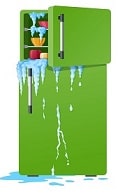
Broken refrigerator with opened freezer, melting ice, and dripping water. Damaged fridge, old kitchen appliance with leakage or crash of the defrosting system. Do not touch Dry Ice directly. Instead, use insulated gloves, potholder, towel, etc. Use the following guidelines for each type of freezer. For each 24-hour period:
(1) Freezer on bottom: use 15 to 25 pounds.
(2) Freezer on top: use 20 to 30 pounds.
(3) Side by side Freezer: use 30 to 40 pounds. Place each slab, starting with the top shelf, on top of the food to be kept frozen. Bottom shelves will be kept frozen by the dry ice above them.
(4) Chest Freezer: use 40 to 50 pounds. When taking out the frozen food, carefully lift the dry ice slab with gloves, a potholder, towel, etc., without touching the dry ice directly.
For each 12 to 24 hour period, place a ten-pound slab of dry ice on the bottom shelf of the refrigerator to cool. Do not touch dry ice with bare hands. Do not place it directly on the glass shelf, but use newspaper or other insulated protection such as a hot pad between the dry ice and the shelf. When the Dry Ice is sublimated, replace it with a new slab. Keep extra dry ice in an ice chest. Because dry ice is frozen CO2 , it will carbonate open containers. Carbonated water is OK, but carbonated milk sure tastes different! Also, anything too close to the dry ice may freeze. Watch out for items below the bottom shelf as they may freeze too. Regular block ice is better for the refrigerator like the old fashion “icebox” – but then one must remove the melted ice water.
A 12×12 walk-in freezer will use 150 to 250 pounds per day. If the fans are running, place half the dry ice as high and close to the back of the evaporator unit where the air is sucked through. Place remainder slabs on top shelves directly on frozen food. Leave the door open when entering the freezer. Carbon dioxide gas will accumulate in the lowest areas and could cause suffocation. Use the buddy system with one person outside the walk-in at all times to help remove items from the walk-in. Leave walk-in if you start to pant and breath quickly or your fingernails or lips start to turn blue. This is the sign that you have breathed in too much CO2 and not enough oxygen.
A 12×12 walk-in refrigerator will use 50 to 100 pounds per day. If the fans are running, place all the dry ice as high and close to the back of the evaporator unit where the air is sucked through. Otherwise, place slabs on top shelves without touching any food. Too much dry ice will lower the temperature too much and freeze food near the floor. Monitor the temperature closely after several hours. Add or subtract dry ice as needed. Keep extra dry ice in an ice chest. Leave the door open when entering walk-in. Carbon dioxide gas will accumulate in the lowest areas and could cause suffocation. Use the buddy system with one person outside the walk-in at all times to help remove items from the walk-in. Leave walk-in if you start to pant and breath quickly or your fingernails or lips start to turn blue. This is the sign that you have breathed in too much CO2 and not enough oxygen.
When finished with the dry ice, unwrap and leave it at room temperature in a well-ventilated area. It will sublimate from a solid to a gas. DO NOT leave dry ice unattended around children.
Witches Brew and Beverages

It is OK to put dry ice into beverages for drinking as long as the dry ice is *food grade. (CO2 used in the beverage industry.)
Use two to three pounds of dry ice for each gallon of room temperature punch. Use large pieces of dry ice, not small pieces. The dry ice is heavier than ice and will sink to the bottom. Do not use any regular ice! The dry ice will do the cooling and must not be eaten or swallowed. Too much dry ice will freeze the beverage, so have extra standing by. When most of the dry ice has sublimed, it will surround itself with ice and float to the top. There is still a small piece of dry ice in the center of these ice pieces, so do not serve or eat them. Carefully ladle the beverage into drinking glasses without any dry ice. Use food dye for colorful drinks.
*(Food grade means the CO2 used to make the dry ice is the same quality CO2 as used for soda fountains, and also the dry ice can be used to transport food and produce.)
See more on our HALLOWEEN page.

WITCHES BREW
A first-grade teacher gave me the best recipe for “witches brew”:
1 can of Grape Juice. (Dark color)
1 can Pineapple Juice. (Strange pulpy texture)
3-5 pounds of food-grade Dry Ice. (Do not use regular ice)
Mix room temperature juices together. When ready for a special brew, add the Dry Ice. Do not touch the Dry Ice directly, but use insulated gloves or potholders. Ladle juice into cups without any Dry Ice, and it will be perfectly safe. If you want cooler drinks to add ice to the cups, not the punch bowl.
See more on our HALLOWEEN page.
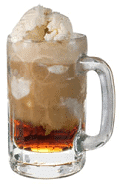
To make one gallon of root beer: Use one pound sugar, one gallon cold water, two ounces of root beer extract, and add 1 to 2 pounds of Food Grade Dry Ice to carbonate.
Tip for carbonation: put in a triple-size plastic container (1/3 liquid and 2/3 air) and put the lid on, letting only a little gas escape. (Too tight creates a possibility of an explosion spraying the rootbeer all over everything. The pressure will dissolve more into the mix and make it fizzier. Otherwise, have Club soda to add for carbonation. Bring several pounds of extra dry ice and put in as you serve to let the kids see the fog’s effect. Do not ladle Dry Ice into cups. Put regular ice directly into cups for additional cooling if needed. For something different, add dry ice to grape juice and pineapple juice for a goulash witches brew.
See more on our HALLOWEEN page.
WhenCO2 is added to plain water; it will make sparkling mineral water. CO2 is extensively used throughout the world in the beverage industry for making soda pop.
See more on our HALLOWEEN page.
Traveling
Use dry ice to keep things frozen; use frozen jell packs to keep things refrigerated and dry; and use regular ice to keep things refrigerated but wet.
Plan on using 10 to 20 pounds of dry ice for every 24-hour period depending upon the ice chest size. Dry ice will keep everything frozen in this ice chest, including extra ice, so consider keeping non-frozen goods refrigerated with regular ice in a separate ice chest. Dry ice sometimes comes in 10-inch squares, 2 inches thick, weighing about 10 pounds each square. Plan to put one square per 15 inches of ice chest length. This will work out to 2 squares (20 pounds) for an average 40-quart cooler. If you can only get pellets, separate them into 10-pound paper bags to spread them around and keep them from falling to the bottom. If you use plastic bags, make sure they are not sealed tight, or they will burst. For larger containers and longer camping or traveling times, multiply dry ice quantities by these rates. Dry Ice, at -109°F or -78°C, will freeze and keep frozen everything in its container until it is completely sublimated. These frozen items will take some extra time to thaw because they have been so cold.
HOW TO PACK DRY ICE
If the dry ice is placed on top of the food (cold sinks), it will work better. However, it is sometimes in the way so many people prefer to keep the dry ice on the bottom of the ice chest for convenience. When packing items in the container, fill all the space, if possible. Any “dead air space” will cause the dry ice to sublimate faster. The best storage container is a three-inch thick urethane insulated box. Lining the inside of your ice chest with sheets of Styrofoam will increase the life of dry ice. Dry ice sublimation (changing from a solid to a gas) will vary depending on the temperature, air pressure, and insulation thickness. The more dry ice you have stored in the container, the longer it will last.
TRANSPORTING BY AUTO OR VAN
Plan to pick up the dry ice as close to the time it is needed as possible. If possible, pack insulating items such as sleeping bags around the ice chest. This will stretch the time that the dry ice lasts. If it is transported inside a car or van (not in the trunk) for more than 10 minutes, ensure fresh air. After 15 minutes with dry ice only in its paper bag in the passenger seat next to me, I started to breathe faster and faster as though I were running a race. I couldn’t figure out why I was so out of breath until I saw the re-circulated position set, not fresh outside air. MAKE SURE FRESH AIR IS COMING IN – EVEN IN THE WINTER!
TRANSPORTING BY AIRPLANE
Pick up dry ice as close to departure time as convenient. Carry it in a well-insulated container such as an ice chest or insulated soft pack. If it is transported inside a car or van for more than 10 minutes, make sure there is fresh air available. Most airlines will allow you to carry no more than 2.5 kilograms (5.5 pounds) of dry ice on the airplane without special arrangements. Because dry ice will sublimate continuously from the time of purchase, you can confidently declare that there are no more than two kilograms when you check-in at the airport. Dry ice will sublimate slightly faster due to the lower pressure that the airline maintains during flight. Make plans to refrigerate or add dry ice when arriving at your destination.
PROTECT SPORT FISH AND GAME
Pack your trophy animal or fish in dry ice to minimize spoilage while transporting or shipping it home. Do not let the dry ice touch the game directly as it may cause superficial damage. Add dry ice to regular ice to extend its cooling. For best results, use an insulated container.
CAMPING STORIES
FROZEN LETTUCE
One time camping, my wife and I had too many leftovers to keep in our ice chest with ice. So we put the salad in our freezer ice chest. The dry ice was only 15 pounds at the beginning of the trip on the bottom of the ice chest, and extra ice was on top of it, and then the salad at the very top. We thought that the ice would be plenty of insulation, but we had a real crispy salad the next morning. A true ice lettuce salad!
HOW TO KEEP ICE FOR WEEKS
One camper reports: “I have a 100-quart Coleman that I pack before leaving with a 50-pound block of dry ice and two 25-pound blocks of regular ice on either side of the dry ice. The dry ice is wrapped in many layers of newspaper, which is a marvelous insulator. If the cooler is kept in the shade and covered with a heavy blanket, the dry ice will last from 8-10 days, at which time the wet ice first begins to melt. This will then last another 4-5 days. I would be willing to bet that using another method I heard (burying the ice chest in sand) in conjunction with mine would keep the wet ice available for 2-3 weeks. However, there is a downside. (1) Keep only frozen foods in the cooler until the dry ice is gone (no beer). (2) Lots of weight — the whole shebang weighs 100 lbs. sans food. Dry ice is very dense – a 50 lb. block is the same size as a 25 lb. block of wet ice.”
OUTFITTER’S SECRET
Jenifer Trout of Pittsburgh, Pennsylvania, reveals John Judson of the Quartercircle-Circle Ranch’s secret:
My family went with an outfitter on a horse packing trip in Colorado last summer. On the second night in the wilderness, John lamented that our menu was screwed up because the ice cream was “too frozen.” He pulled it out of the cooler and bounced it on a slab of wood. It was a brick! He’d brought the food in 2 small coolers, which doubled as stools. One was for refrigerated food, and the other was for frozen food. He’d move some food (mostly meat) from the frozen cooler to the refrigerated cooler each day. He used no wet ice or ice packs at all. We had ice cream on our third night out – after it had thawed to an appropriate temperature in the refrigerated cooler. His trick was a block of dry ice wrapped in newspaper – and it worked unbelievably well!
School Projects


Learn how to build an icy model of a comet, complete with shooting jets. This activity allows students to make observations, discuss changing states of matter and demonstrate measuring skills. From Jet Propulsion Laboratory.
 JennyPPhoto / Getty Images
JennyPPhoto / Getty Images
VOLCANO
Dry Ice can add the right touch to the typical school volcano. The “smoke” will come out the top and flow down the sides for several minutes. Inside the volcano, put a container to hold hot water. If hot water is not immediately available, use a thermos. The hotter the water is (but not boiling), the better. Seal the bottom of the volcano tightly. At the time of the eruption, use gloves and put small pieces of dry ice into the hot water. The volcano will bubble and “smoke” for several minutes. Volcano projects can get messy, so plan for some clean-up time.
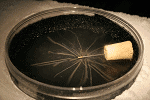 CLOUD CHAMBER
CLOUD CHAMBER
An easy-to-make cloud chamber can be used to observe Alpha or Beta particles. Use a clear Pyrex or Corning shallow glass container that will not break in a freezer. Cover the bottom inside of the dish with black felt or black paper. Cut a piece of cardboard larger than the top of the dish. Pour alcohol on one side of the cardboard. Place the cardboard on the dish with the wet side down. Heat the top cardboard with your hand or something else warm, such as a hot iron. Place the dish on a slab of Dry Ice. The alcohol will form a cloud. Shine a light through the side of the dish to observe vapor trails. Some natural vapor trails can be seen in time, although you may have to put alcohol on the cardboard several times. Place an alpha ray source such as an old-fashioned illuminated watch dial or a Coleman lantern mantel inside to see more ion trails in the cloud chamber. Use a light source such as a bright flashlight to see the cloud tracks better.
BAKING SODA
Sodium hydrogen carbonate (NaHCO3), also called Sodium bicarbonate, bicarbonate of soda, and baking soda, is an important chemical. Hundred of thousands of tons are produced each year for use in baking and in producing other chemicals. One way to make this compound at home or in the school chemistry laboratory is to use dry ice, salt, ammonium carbonate, and vinegar.

Dry Ice Investigations
“This unit revolves around the intriguing nature of dry ice and the incessant curiosity it provokes in all those who have the opportunity to interact with it. Whenever science (especially chemistry) is depicted on film or television, you can almost guarantee that you’ll see dry ice bubbling away in a colorful liquid. Music videos, scary movies, theatrical plays, and Halloween frequently feature its eerie heavy fog slowly and silently creeping across a surface. Although it is perhaps the ultimate symbol of “fun science,” students rarely have the opportunity to explore it themselves in science class, most likely because many teachers often don’t know where to get it, don’t know what to do with it, and are intimidated by safety issues. This guide hopes to deal thoroughly with all these issues and to build on the wondrous appeal of dry ice to provide a highly memorable and powerful science learning experience.”
One of the best science books for grades 6-8, “Dry Ice Investigations” from LHS Gems, UC Berkeley, (ISBN: 0-924886-15-3), available through Amazon.com and other suppliers.
How to Make Dry Ice
FUN THINGS TO DO WITH DRY ICE! From Five Marys Farms
Cool Dry Ice Projects
14 Experiments With Solid Carbon Dioxide
Dry Ice: Environmental Friend or Foe?
An interesting Blog: Dry Ice: Environmental Friend or Foe?
Science
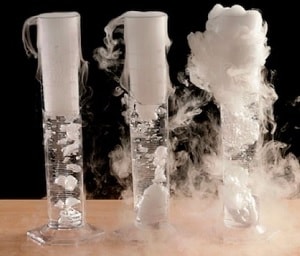
PHYSICAL DESCRIPTION
Dry ice is frozen carbon dioxide, a normal part of our earth’s atmosphere. It is the gas that we exhale during breathing and the gas that plants use in photosynthesis. It is also the same gas added to water to make soda water. Dry ice is beneficial for freezing and keeping things frozen because of its frigid temperature: -109.3°F or -78.5°C. Dry ice is widely used because it is simple to freeze and easy to handle using insulated gloves. Dry ice changes directly from a solid to a gas -sublimating – in normal atmospheric conditions without going through a wet liquid stage. For more information on carbon dioxide, see Wikipedia.
The first step in making dry ice is to compress carbon dioxide gas until it liquefies, at the same time removing the excess heat. The CO2 gas will liquefy at a pressure of approximately 870 pounds per square inch at room temperature. Next, the pressure is reduced over the liquid carbon dioxide by sending it through an expansion valve into an empty chamber. The liquid will flash, with some turning into gas, causing the remainder to cool. As the temperature drops to -109.3°F, the temperature of frozen CO2 will freeze into dry ice snow. This dry ice snow is compressed together under a large press to form blocks or extruded into various sized pellets. Dry ice is much heavier than traditional ice, weighing about double.
For each 15-minute period, put 5 to 10 pounds of Dry Ice into 4 to 8 gallons of hot water. This will make lots of fog depending upon the temperature of the water and the size of the pieces of dry ice. Hotter water will make more fog. Boiling water will add its own rising steam to the vapor cloud. If there is no steam, the fog will flow downhill and in the direction of any air movement. A small fan can help control the direction. Smaller pieces of dry ice with more surface area produce a greater fog volume and cool the water down much faster. In both cases, the result is more fog for a shorter amount of time. Keep the water hot with a hot plate, electric skillet, or some other heat source to produce fog for a longer time. Otherwise, when the water gets too cold, it must be replaced to continue the fog effects. If the container is filled with water, the fog will flow over the sides the best. But the dry ice sublimation will vigorously bubble the water and splash it out. Even a ¾ filled container will splash some, so placing the container where spilled water will not ruin anything. The water vapor fog will also dampen the area it flows across. Be careful because, after some time, floors do get slippery.
Additional information about dry ice fog.

A theater fog machine could be a 30 to 55-gallon metal or plastic water barrel with a 110 or 220-volt water heater. Dry Ice is placed in a bucket with holes to allow hot water to enter it when lowered.
When the bucket is lowered into the hot water, fog is instantly produced. The resulting water vapor fog is gently blown by a fan and directed to the desired. Fog stops whenever the bucket of dry ice is pulled out of the water. More recent fog machines pump heated water over a tray holding the dry ice. All have a GFCI circuit breaker for safety.
Special Effects
HOW TO CREATE DRY ICE FOG
For each 15-minute period, put 5 to 10 pounds of dry ice into 4 to 8 gallons of hot water. This will make lots of fog depending upon the temperature of the water and the size of the pieces of dry ice. Hotter water will make more fog. Boiling water will add its own rising steam to the vapor cloud. If there is no steam, the fog will flow downhill and in the direction of any air movement. A small fan can help control the direction. Smaller pieces of dry ice with more surface area produce a greater fog volume and cool the water down much faster. In both cases, the result is more fog for a shorter amount of time. Keep the water hot with a hot plate, electric skillet, or some other heat source to produce fog for a longer time. Otherwise, when the water gets too cold, it must be replaced to continue the fog effects. If the container is filled with water, the fog will flow over the sides the best. But the dry ice sublimation will vigorously bubble the water and splash it out. Even a ¾ filled container will splash some, so placing the container where spilled water will not ruin anything. The water vapor fog will also dampen the area it flows across. Be careful because, after some time, floors do get slippery.
Additional information about dry ice fog.

The Phantom Of The Opera Scene Four.
Many shows are enhanced by adding flowing fog using dry ice in a fog machine or buckets of hot water and a fan.
I have seen it most often in the dance of the snowflake fairies in the Nutcracker Suite, and it is frequently used in Brigadoon and Oklahoma for their dream scenes.
Here is used in The Phantom Of The Opera, The Labyrinth Underground.
The Phantom and Christine take their strange journey to the Phantom’s lair. Candles rise from the stage. We see them in a boat that moves slowly across the misty waters of the underground lake.

This injury came from holding the bottle when it ruptured! Luckily it missed both eyes!
Dry ice exploding from confined spaces can be loud and dangerous. Small pieces of dry ice placed in an empty one-liter plastic soda bottle and then filled ¼ to ½ with hot water may explode immediately or several minutes later. It also may crack anywhere and fizzle. Wear gloves and eye protection because the resulting explosion may dangerously push out pieces of the plastic bottle or the bottle top. A woman in Houston standing too close lost her eye from the ejected bottle top. Please make sure no one is holding the bottle nor anyone near it when it explodes. Although the explosion sprays mostly carbon dioxide gas and water, many municipalities outlaw them. Sometimes these dry ice bombs are called “terrorist devices,” and people using them are arrested. In our area, several teenagers were jailed for three days for setting off these dry ice firecrackers. The logical defense explains no chemical reaction – only a change in the state of matter – from a solid to a gas. Unfortunately, there may be high legal fees to persuade a DA or judge of this fact. Therefore DO NOT DO THIS IF IT IS ILLEGAL IN YOUR COMMUNITY! For safety, DO NOT EVER ALLOW CHILDREN TO DO THIS. Always supervise children around the dry ice. Of course, using anything other than plastic bottles is even more dangerous and by no means should ever be permitted!


